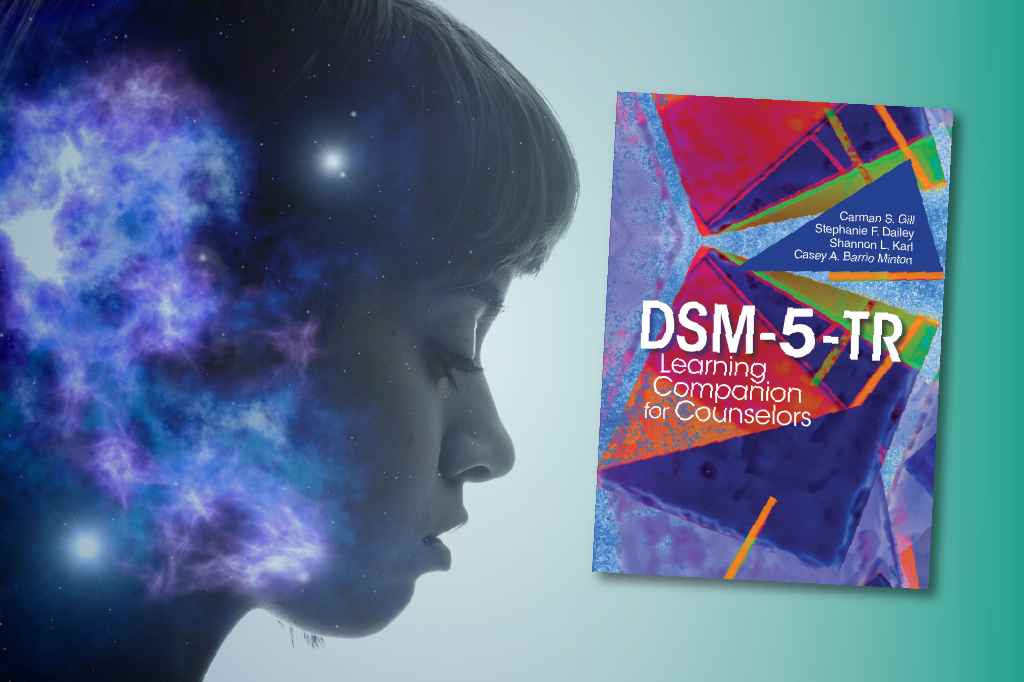Behind the Book: A Conversation with the Authors of the DSM-5-TR Learning Companion for Counselors
May 2024

The fifth edition of the Diagnostic and Statistical Manual of Mental Disorders (DSM) underwent another revision in 2022, which resulted in the DSM-5-TR. This updated version added prolonged grief disorder, modified criteria for certain disorders, and revised its language to be more inclusive and reflective of race, ethnicity, gender and discrimination.
For counselors, remaining up to date on changes to this diagnostic manual and understanding how the changes relate to their clinical work is often a tedious task. In their book DSM-5-TR Learning Companion for Counselors, Carman Gill, PhD, LPC; Stephanie Dailey, EdD, LPC; Shannon Karl, PhD, LMHC; and Casey Barrio Minton, PhD, provide an overview of these changes and offer advice on how counselors can apply these changes in clinical practice. (Note: This is a revised edition of their 2014 book DSM-5 Learning Companion for Counselors.)
We recently spoke with the authors to learn more about their latest book and the recent revisions to the DSM. Gill is a professor of clinical mental health counseling and department chair of the Department of Counseling and Education at Florida Atlantic University. Dailey is an assistant professor of counseling at George Mason University. Karl is a professor of counseling at Nova Southeastern University. Barrio Minton is a professor of counselor education and department head of the Educational Psychology and Counseling Department at the University of Tennessee, Knoxville.
What are the biggest changes with the DSM-5-TR that counselors need to be aware of?

Carman Gill: One of the noteworthy changes to the DSM-5-TR is the heightened focus on culture, racism and discrimination. Our learning companion also reflects updates for the over 70 criteria code sets that are modified in the DSM-5-TR, including clarification of wording from the DSM-5 and updated ICD-10-CM codes. We covered the new ICD-10-CM codes for suicidal behavior and nonsuicidal self-injury, which practitioners can use without assigning another diagnosis.
We also added a new chapter addressing sociocultural issues with diagnosis and focusing on how culture is defined in the DSM-5-TR, including recent updates intended to better reflect the impact of culture, race and social determinants on health. The book provides an explanation of sociocultural considerations in diagnosis and treatment planning and a framework to guide counselors in understanding the limitations of the DSM-5-TR, as well as opportunities to approach diagnosis and treatment planning more holistically.
What new or updated cultural considerations are presented in the DSM-5-TR?

Casey Barrio Minton: The American Psychiatric Association (APA) created a task force of subject matter experts to help develop this latest version of the DSM. The DSM-5-TR Task Force included extensive attention to cultural considerations in the revision process, with one cross-cutting review group dedicated to sex and gender and another to culture. APA also formed an Ethnoracial Equality and Inclusion work group to review the text and ensure it took into consideration the impact of racism and discrimination on mental health. In the end, the revision included substantial changes to text sections regarding culture-related diagnostic features and sex- and gender-related diagnostic features. APA also updated sections on symptom presentations and prevalence to be more nuanced when attending to identity and culture.
The meaningful shifts in language throughout the DSM-5-TR are less stigmatizing and highlight social determinants of mental health. Terms such as racialized denote the social construction of race. This new edition of the DSM also introduces a new term ethnoracial, which aims to capture a combination of ethnic and racialized identities. Finally, gender dysphoria was edited to reduce stigma and choice narratives. Counselors will now find terms such as experienced gender, gender-affirming medical procedure, individual assigned male/female at birth and differences in sex development in the DSM-5-TR.
Why did you choose to include two new chapters on sociocultural issues and culturally responsive care?
CBM: The Multicultural and Social Justice Counseling Competencies are a signature of the counseling profession. Integration of culture in the counseling process is a philosophical commitment of our profession alongside development, holistic wellness, strengths, orientation and prevention. While we have made strong strides in this area, a lot of the talk about sociocultural issues and culturally responsive care in counseling is more aligned with conceptual values than enactment in the counseling relationship. We included these two chapters in hopes of helping counselors actively integrate attention to culture and social determinants of mental health in diagnosis and treatment planning.
How does your book help counselors who may feel unprepared or uncomfortable when diagnosing clients?

Shannon Karl: The DSM-5-TR Learning Companion for Counselors helps professional counselors better understand the diagnostic process by including sections on differential diagnoses, applied case studies and helpful information across diagnostic categories. The book highlights key areas for counseling professionals, such as the new diagnosis of prolonged grief disorder, updated nomenclature and text devoted to non-suicidal self-injury and cultural contexts. The specific breakdown of key information can assist all professional counselors with understanding the DSM-5-TR in a way that provides for accurate diagnosis and best treatment practices.
How do the changes to the DSM and the Health Insurance Portability and Accountability Act affect assessment and diagnosis?
SK: The DSM-5-TR contains changes in the nomenclature for several diagnoses, such as eliminating the term dysthymia for the broader persistent depressive disorder, that are important to incorporate when conducting assessment and diagnosis. The parameters of the Health Insurance Portability and Accountability Act align with health care privacy and accurate diagnosis leading to the implementation of effective treatment interventions. One benefit of the updated manual is the inclusion of additional harmonization and coding alignment with the International Classification of Diseases, which allows for consistent diagnosis and treatment practices.
What problems or challenges are still present with how the DSM-5-TR conceptualizes or defines mental health issues?

Stephanie Dailey: The DSM-5-TR, while a valuable tool in diagnosing mental health disorders, faces several ongoing challenges in how it conceptualizes and defines these issues. Critics argue that the manual may overpathologize normal behaviors, potentially leading to unnecessary diagnoses and medicalization of common human experiences. Additionally, concerns persist regarding cultural biases inherent in the DSM, with some arguing that its reflection of Western norms and values could result in the misdiagnosis or underdiagnosis of individuals from diverse cultural backgrounds. Our book addresses these challenges by integrating information on sociocultural issues into each chapter, including two new chapters dedicated to sociocultural concerns and the DSM and culturally responsive care. This equips counselors with essential knowledge to avoid pathologizing clients and provides strategies for adopting a holistic, wellness-focused perspective on the human experience.
What challenges do counselors often face when trying to apply DSM-5-TR nomenclature in their own clinical practice? And how does your book help them address these challenges?
SD: Counselors face numerous challenges when applying DSM-5-TR nomenclature in their clinical practice, including complexity of diagnostic criteria, cultural considerations and diagnostic labels. The manual provides detailed guidelines for various mental health disorders, but it can be challenging to navigate these guidelines in real-world settings. Because the DSM-5-TR may not fully address cultural variations in symptom presentation and diagnostic thresholds, it can potentially lead to misdiagnosis or underdiagnosis among individuals from diverse cultural backgrounds. Furthermore, applying diagnostic labels from the DSM-5-TR can perpetuate stigma and self-labeling among clients, impacting their self-esteem and engagement in treatment.
Our book addresses these challenges by providing practical guidance and strategies for counselors to navigate the complexities of applying DSM-5-TR nomenclature in their clinical practice. It offers insights on how to interpret and apply diagnostic criteria effectively, emphasizing the importance of considering comorbidity and individual variations in symptom presentation. Additionally, our book provides guidance on culturally responsive assessment practices, which helps counselors integrate cultural considerations into their diagnostic process. Moreover, it offers approaches for reducing stigma and promoting empowerment in clients, encouraging counselors to use diagnostic language judiciously and collaboratively with clients. Finally, the book highlights the importance of ongoing learning and adaptation in the field of mental health. We empower counselors to stay informed and responsive to evolving knowledge and terminology.
Order DSM-5-TR Learning Companion for Counselors at the ACA Store.
Learn more about the changes in the DSM-5-TR in the Counseling Today article “What’s new with the DSM-5-TR?”
Search CT Articles
Current Issue
Sign Up for Updates
Keep up to date on the latest in counseling practice. Sign up to receive email updates from Counseling Today.


